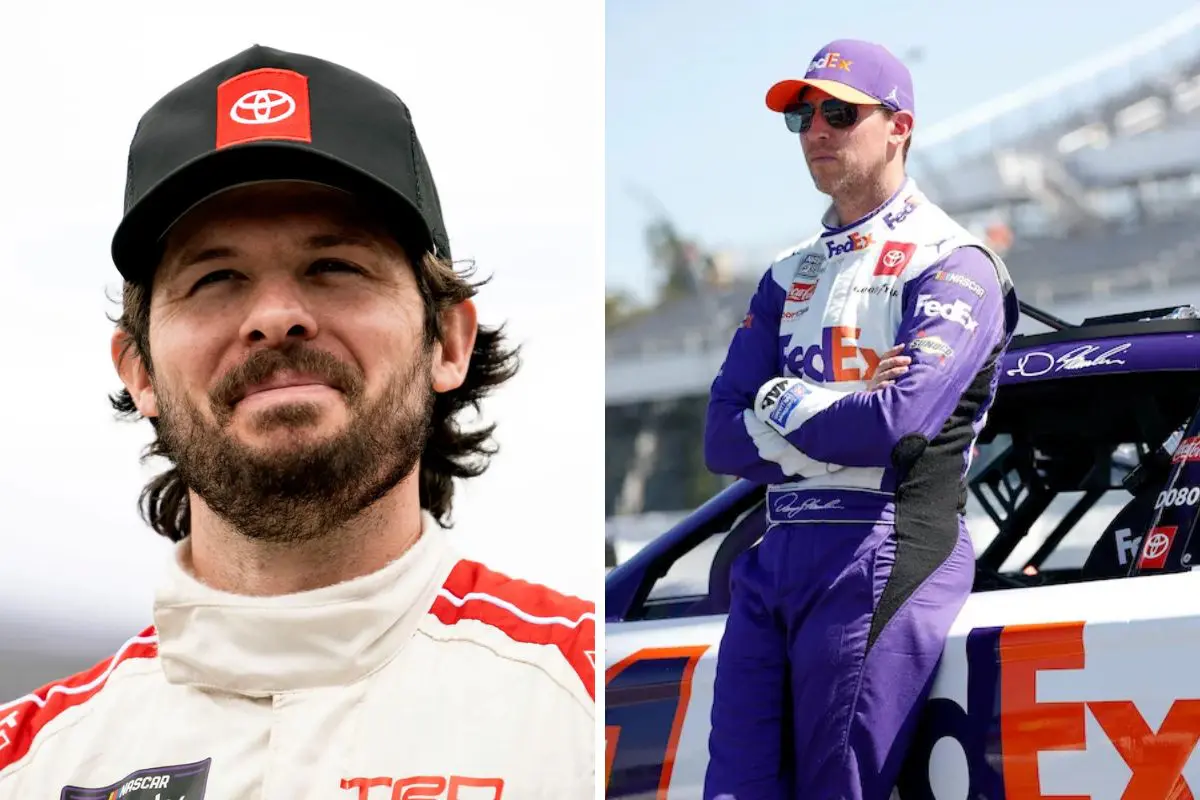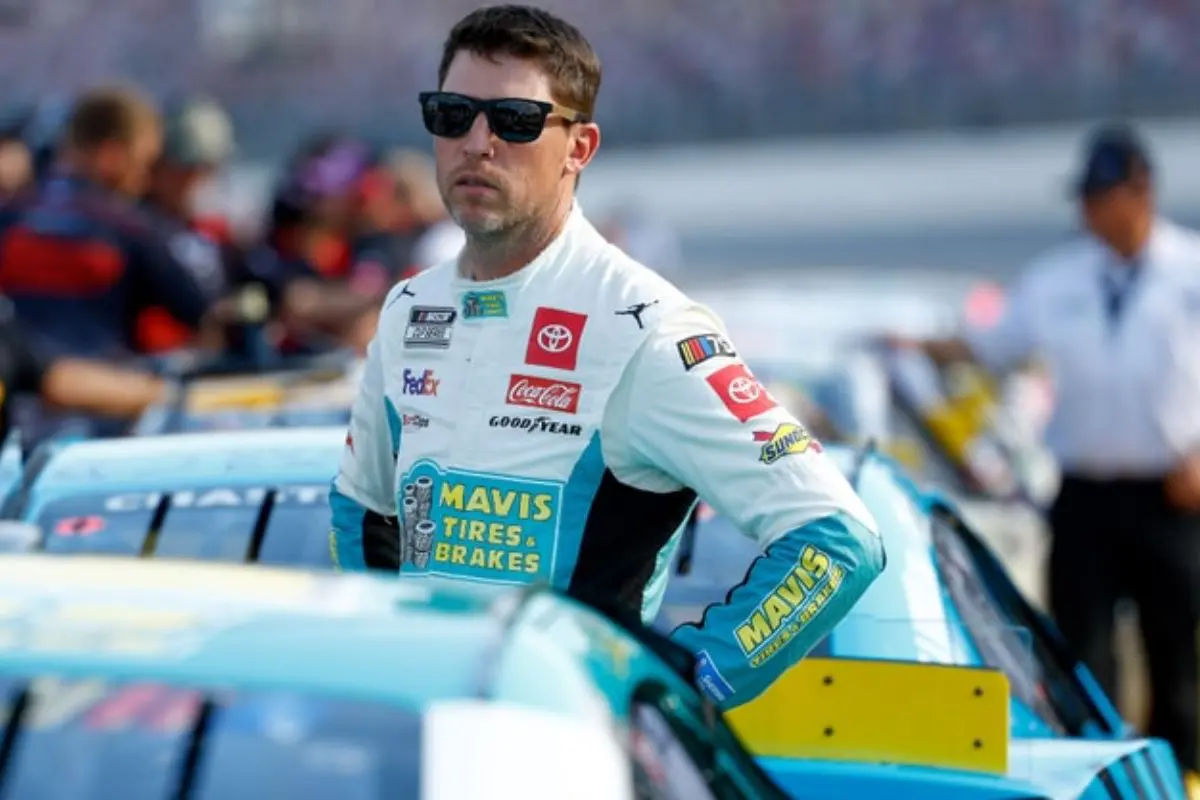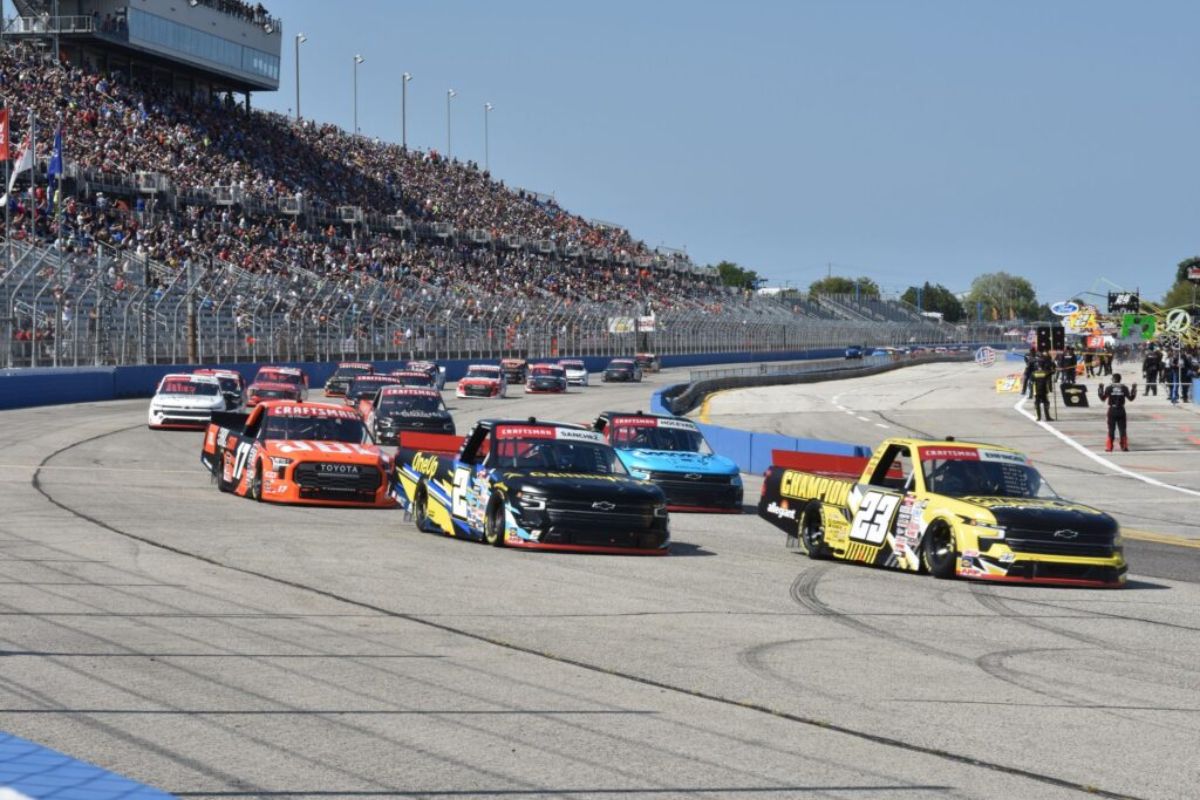Denny Hamlin’s Critique Backed by Ryan Truex: Ryan Truex’s endorsement of Denny Hamlin‘s critique regarding the inadequacies of NASCAR’s shark-fins raises critical questions about driver safety and vehicle design. Truex emphasizes the pressing need for a reassessment of these aerodynamic features, which, rather than enhancing safety, may inadvertently contribute to the severity of crashes. This dialogue reflects a growing concern among drivers and prompts an examination of NASCAR’s historical safety measures and their evolution. As the stakes in the sport continue to rise, the implications of these design flaws become increasingly important, warranting a deeper exploration of potential reforms.
Key Highlights
- Ryan Truex agrees with Denny Hamlin’s criticism regarding the effectiveness of the current shark-fin designs in enhancing driver safety.
- Both drivers express concerns over the rollover risks that persist despite the introduction of shark fins in NASCAR vehicles.
- Truex emphasizes that direct wall collisions remain more dangerous than flipping incidents, questioning the overall safety innovations.
- The need for improved vehicle aerodynamics and designs is highlighted by Truex, underscoring potential flaws in the current shark-fin approach.
- Truex advocates for NASCAR to actively address these design issues to ensure better safety standards for drivers on the track.
Recent Crashes and Incidents
Recent events on the NASCAR circuit have emphasized the inherent dangers of high-speed racing, as exemplified by a series of alarming incidents that have raised concerns among drivers and fans likewise.
The most striking example occurred during the rain-delayed race at Michigan, where Corey LaJoie performed an overtaking action that resulted in a Destructive collision with Noah Gragson. LaJoie’s No. 7 Chevy became airborne, flipping several times before ultimately resting on the grass. Fortunately, LaJoie emerged unscathed; however, the incident served as a glaring reminder of the threatening of racing dynamics.
These incidents are not isolated. The Daytona outing further showed the volatility of vehicular stability, with further flipping crashes that highlighted the challenges NASCAR faces in maintaining safety amidst high-speed competition.
Despite NASCAR’s efforts to introduce regulatory measures aimed at minimizing these incidents, the efficacy of such interventions remains questionable.
Moreover, the commentary from drivers like Martin Truex Jr. and Denny Hamlin reflects a growing sentiment that the severity of these crashes may not be as alarming as initially perceived. This perspective prompts critical analysis of the mechanical design of the cars, particularly the controversial shark-fin elements, which are believed to contribute to aerodynamic instability.
The recurring nature of these incidents raises pressing questions about the balance between thrilling competition and driver safety, necessitating a re-evaluation of both engineering specifications and accident prevention strategies within the NASCAR framework.
Denny Hamlin’s View on Crash Severity
The ongoing discourse surrounding crash severity in NASCAR has been considerably shaped by Denny Hamlin’s perspective, which emphasizes a subtle understanding of the mechanics of racing accidents. Hamlin’s insights draw attention to the nature of impacts and how different crash scenarios can influence driver safety. His assertion that flips, similar to those experienced by Corey LaJoie, create less impact than wall collisions has generated notable discussion among fans and analysts as well.
Hamlin’s comparison is critical, as it highlights the following key points:
- Nature of Impact: Flips often result in less direct force compared to head-on wall crashes.
- Historical Context: The legacy of wall crashes in NASCAR, particularly incidents like Dale Earnhardt’s tragic accident, emphasizes the potential for severe injuries.
- Driver Perception: Hamlin’s views resonate with other seasoned drivers, including Dale Earnhardt Jr., reinforcing a consensus on crash dynamics.
- Safety Innovations: In response to recent incidents, NASCAR’s implementation of shark fins aims to mitigate liftoff risks and improve overall safety.
As the sport continues to evolve, the dialogue surrounding the mechanics of crashes and the resulting driver safety will remain paramount, influencing future regulations and technology in racing.
Effectiveness of Recent Safety Innovations
Numerous discussions have emerged regarding the effectiveness of safety innovations in NASCAR, particularly in view of recent incidents during races such as the Coke Zero Sugar 400. The introduction of the shark fin was expected to reduce the likelihood of cars flipping during high-speed collisions; however, its performance during the event raised questions about its efficacy.
“I don’t think the shark fin worked…We had two cars flip over this weekend instead of one.” – FREDDIE KRAFT
Remarkably, both Michael McDowell and Josh Berry experienced flips, with Berry’s situation culminating in a dangerous landing on his roof. This outcome suggests that the shark fin may not have provided the intended stability in precarious situations.
The 4 was a blowover…You can see that car (No. 2) trying to lift, and it didn’t do the same as the 4 did. I don’t know if the fin was helping that situation but it did not help the 4.” – KRAFT
Freddie Kraft’s analysis highlighted that while one car illustrated a half-flip, the other, despite the presence of the fin, experienced a complete overturn. This discrepancy indicates that the innovation may not uniformly mitigate the risk of rollovers, leading observers to reconsider its design and implementation.
“That’s not a position that I would wanna be in at all.” – T.J. Majors
Ryan Truex’s insights resonate with this skepticism, as he acknowledges the inherent dangers of flipping yet emphasizes that the impact of a direct wall collision remains considerably more severe. His perspective invites a reevaluation of prioritizing innovations that genuinely improve driver safety over those that merely address specific types of accidents.
“Yeah, for sure. I’ve never flipped in a stock car but I have flipped…Hitting a wall head-on definitely hurts a lot more. Or side-on, any way you hit the wall, it doesn’t feel good.” – Ryan Truex
Historical Context of NASCAR Safety Measures
Throughout its history, NASCAR has undergone considerable transformations in safety protocols, particularly following tragic incidents that highlighted the inherent dangers of motorsport. The loss of Dale Earnhardt in 2001 served as a watershed moment, compelling NASCAR to adopt stringent safety measures to protect its drivers. This evolving landscape of safety is marked by key innovations and policy changes aimed at mitigating risks.
Notable milestones include:
- SAFER Barriers: Introduced to reduce the impact during crashes, these barriers have become standard at tracks nationwide.
- HANS Device: This head and neck restraint system markedly decreased the risk of basilar skull fractures, a common cause of fatalities.
- Enhanced Vehicle Design: Structural modifications have been implemented to improve cockpit safety and energy absorption during impacts.
- Ongoing Education: Continuous learning from both tragic and non-fatal incidents has fostered a culture of safety within the sport.
The 2020 Daytona 500 incident, where Ryan Newman’s car flipped and caught fire, further emphasized the need for constant vigilance and innovation in safety measures.
“I’ve watched every angle that I could possibly watch. The biggest problem is I don’t have any memory of my own angle, which is the ultimate angle. And that’s gone, and that will always be gone no matter how many times I watch a replay or different variations of that replay.” – Ryan Newman
Newman’s reflection on his experience demonstrates the psychological toll accidents can impose on drivers, stressing that the sport must remain committed to evolving safety strategies.
As NASCAR moves forward, it must remain steadfast in its dedication to learning from past tragedies while implementing modern technologies to safeguard the lives of those who participate in the sport.
Future Safety Measures and Hope for Improvement
A thorough approach to future safety measures in NASCAR is essential to address the evolving challenges faced by drivers on the track. The recent incidents involving flips and wall crashes highlight the urgent necessity for improved vehicle design and track safety protocols. As the sport witnesses increasing speeds and more aggressive driving styles, the current safety standards may no longer suffice to protect competitors adequately.
In view of these dangerous occurrences, it is imperative that NASCAR revisits and fortifies its safety measures. Innovations in car construction, such as reinforced roll cages and advanced energy-absorbing materials, could greatly mitigate the impact forces experienced during accidents.
Furthermore, the implementation of more stringent testing protocols prior to races would guarantee that all vehicles meet enhanced safety criteria, thereby reducing the likelihood of catastrophic failures.
Moreover, track design must evolve alongside vehicle improvements. The introduction of softer barriers and improved runoff areas can greatly diminish the severity of collisions, offering drivers a greater margin of safety.
“We will always continue to learn from those that we lose and those that we don’t lose, as long as we keep focused on the things that we need to to increase our level of safety.”
As exemplified by other motorsport organizations, a collaborative approach involving drivers, engineers, and safety experts can yield thorough solutions tailored to the unique demands of NASCAR.
The hope for improvement lies not only in technological advancements but also in fostering a culture of safety within the sport. By prioritizing the well-being of drivers and remaining vigilant to emerging risks, NASCAR can set a precedent for excellence in safety standards, ultimately guaranteeing that the thrill of racing does not come at the cost of human life.
News in Brief: Denny Hamlin’s Critique Backed by Ryan Truex
In view of the concerns raised by Ryan Truex and Denny Hamlin regarding the inadequacies of NASCAR’s current shark-fin designs, it becomes imperative for the organization to reevaluate its approach to driver safety. The analysis of recent incidents highlights the necessity for improved aerodynamic innovations that prioritize driver protection. Historical context reveals a pattern of evolving safety measures, yet the urgency for reform remains paramount. A commitment to continuous improvement in vehicle design is crucial for safeguarding the well-being of competitors.
ALSO READ: Ryan Truex Opens Up About JGR Snub: A Disheartening Truth




